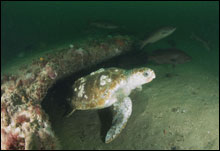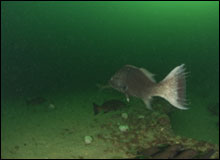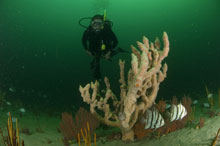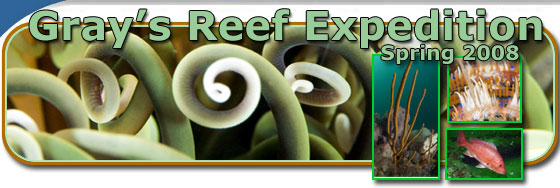Error processing SSI file
|
Mission Log: May 10, 2008
NOAA Ship Nancy Foster
By Greg McFall
Research Coordinator
Gray's Reef National Marine Sanctuary
Well…today is our last day at sea and we were able to get in three dives. We’ve been mapping the seafloor to identify new places outside the boundaries of the sanctuary and our multibeam technicians have identified a couple of new places to explore.
On the first dive, we went to a new site located south of the southern sanctuary boundary. Lieutenant Lecia Salerno and I went on the first dive and were surprised to find that there were grouper coming up off the bottom to meet us! There were many gag and scamp grouper and lots of red snapper on the small (2 feet high) ledge that we were to explore. Halfway through the dive we were surprised to see a female loggerhead sea turtle resting underneath the ledge. She came out when she saw us and stayed around just long enough for me to take some pictures of her.
 |
|
Female Loggerhead Sea turtle.
|
Apparently it’s breeding season for many species at Gray’s Reef and the turtles are no exception. During this time of year the females will rest up and forage (eat) at Gray’s Reef and before long they’ll be making their way to the beaches to lay their eggs. They may nest several times in one season.
 |
|
Scamp Grouper showing breeding coloration
|
The scamp grouper appear to be reproducing as well. We saw several large males whose skin pattern had changed and which were chasing some of the females around the reef. Grouper can make sounds by vibrating the muscles which surround their swim bladder (air bladder) and if you’re listening for it you’ll hear the “boom, boom, boom” sound that they make when they’re trying to encourage a female to mate with them.
On the next two dives, Missy Partyka and I explored an area where there were no ledges on the seafloor but where there were a lot of different kinds of fishes, sponges and soft corals. This type of habitat is not very densely colonized by organisms but what animals are attached to the bottom are quite large. There were several large sponges and soft corals present and these animals can become shelter for many other species of fishes and invertebrates.
 |
|
Branching sponge being used as shelter for small fishes
|
Sadly, the cruise must come to an end tomorrow. We’ve had some setbacks with the weather and diving but we’ve accomplished a lot. We’ve mapped areas outside the reef that are larger than what we’ve mapped inside Gray’s Reef so we’re very happy to have been so productive. This would not have been so productive were it not for the help of students (Katrina and Andrew) of Dr. Leslie Sautter from College of Charleston and the help of Ms. Christine Taylor from our headquarters office in Silver Spring, MD. We were fortunate enough to have some wonderful teachers, Venetia, Fran and Jim along with us on this trip and we hope that the experience they had will help to renew their excitement for science that they can then take back to their respective schools and imbue the students with a sense of that same enthusiasm gained from their experiences at sea aboard NANCY FOSTER.
Be sure to check back next cruise (Starting Tuesday) for more excitement at sea as we start the fish tagging phase of our science at sea.
|








